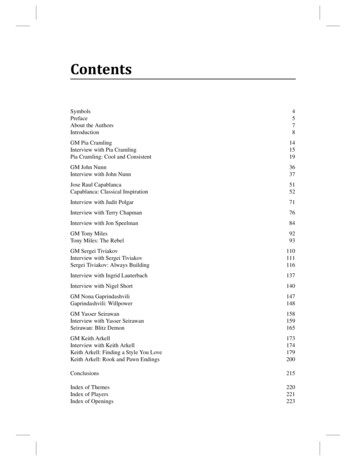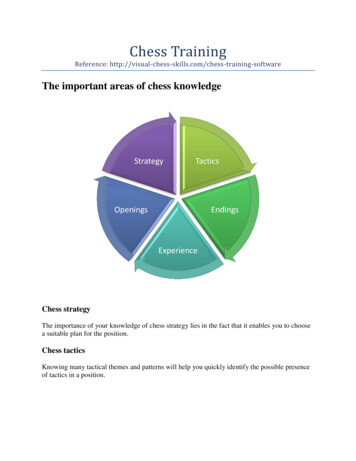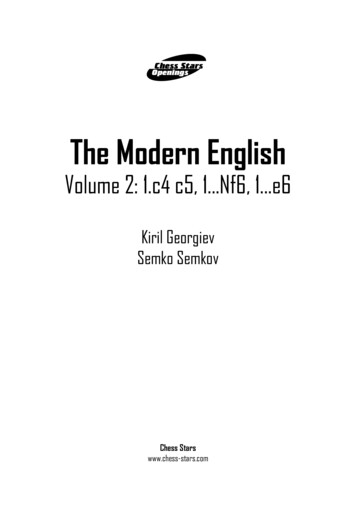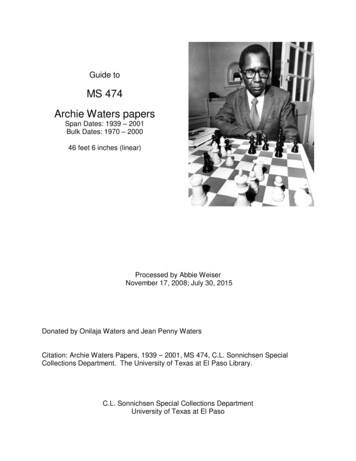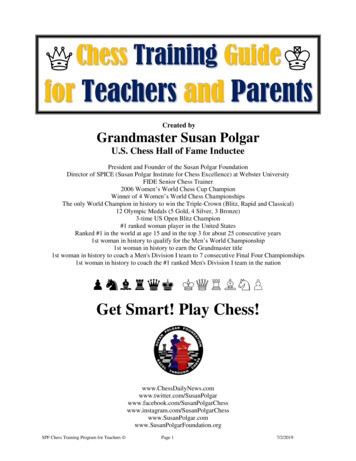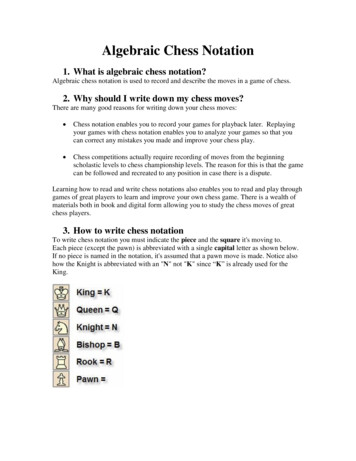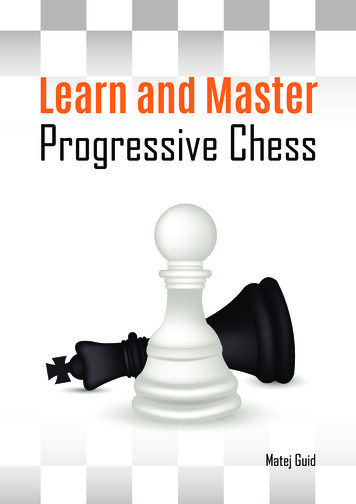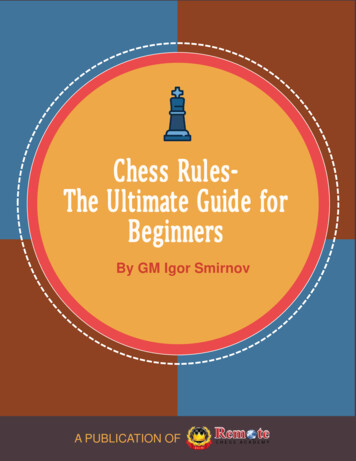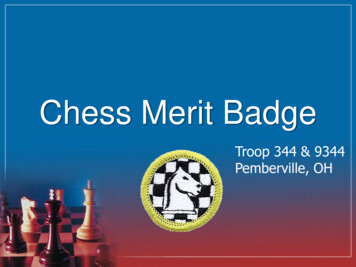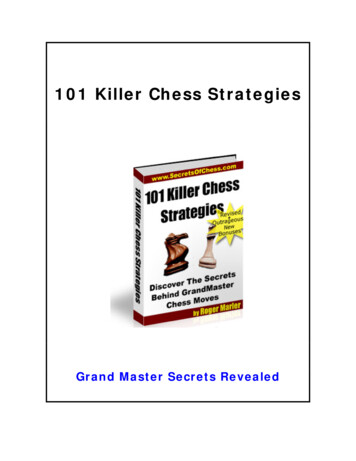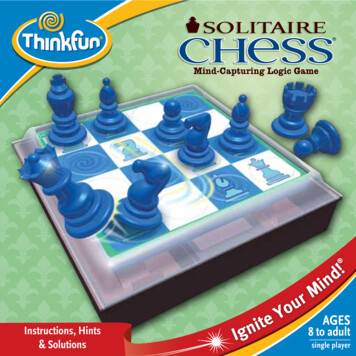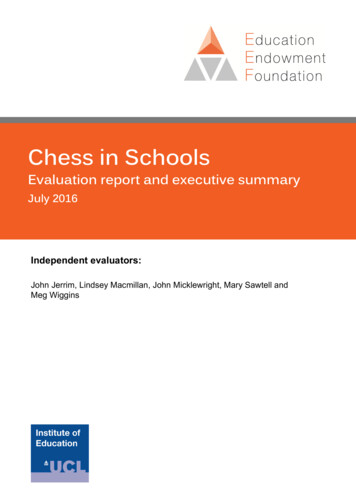
Transcription
Chess in SchoolsEvaluation report and executive summaryJuly 2016Independent evaluators:John Jerrim, Lindsey Macmillan, John Micklewright, Mary Sawtell andMeg Wiggins
Chess in SchoolsThe Education Endowment Foundation (EEF) is an independent grant-making charity dedicated tobreaking the link between family income and educational achievement, ensuring that children from allbackgrounds can fulfil their potential and make the most of their talents.The EEF aims to raise the attainment of children facing disadvantage by: identifying promising educational innovations that address the needs of disadvantagedchildren in primary and secondary schools in England;evaluating these innovations to extend and secure the evidence on what works and canbe made to work at scale; andencouraging schools, government, charities, and others to apply evidence and adoptinnovations found to be effective.The EEF was established in 2011 by the Sutton Trust as lead charity in partnership with Impetus Trust(now part of Impetus - Private Equity Foundation) and received a founding 125m grant from theDepartment for Education.Together, the EEF and Sutton Trust are the government-designated What Works Centre for improvingeducation outcomes for school-aged children.For more information about the EEF or this report please contact:Danielle MasonHead of Research and PublicationsEducation Endowment Foundation9th Floor, Millbank Tower21–24 MillbankSW1P 4QPp: 020 7802 1679e: danielle.mason@eefoundation.org.ukw: www.educationendowmentfoundation.org.ukEducation Endowment Foundation1
Chess in SchoolsAbout the evaluatorThe project was independently evaluated by a team led by University College London, including JohnJerrim, Lindsey Macmillan, John Micklewright, Mary Sawtell and Meg Wiggins.The lead evaluator was John Jerrim.e. j.jerrim@ucl.ac.ukEducation Endowment Foundation2
Chess in SchoolsIntroductionContentsAbout the evaluator . 2Contents . 3Executive Summary . 4Introduction. 6Methods . 10Impact evaluation . 19Process evaluation . 33Conclusion . 48References . 51Appendix A. School consent form to access the National Pupil Database (NPD). 52Appendix B. Questions CSC were asked to estimate costs . 53Appendix C: Padlock rating . 54Appendix D: Cost rating. 55Education Endowment Foundation3
Chess in SchoolsIntroductionExecutive SummaryThe projectChess in Primary Schools is a whole-school approach to teaching primary school children how to playchess. Children take 30 hours of chess lessons delivered by a tutor who is an experienced chessplayer, and the school is given the option to set up a chess club as a lunchtime or after-school activity.Chess classes are delivered during the school day and are expected to replace subjects such asmusic or PE.The intervention was evaluated using a two-armed randomised controlled trial. The trial took placeover the 2013/2014 academic year and assessed the impact of one year of Chess in Primary Schoolson the mathematics attainment of pupils in Year 5. It was an effectiveness trial, with the interventiontested under realistic conditions in a large number of schools. This study looks at whether theintervention had an impact on attainment one year after the intervention had ended in June 2015. Onehundred schools across 11 local education authorities (LEAs) in England participated in the trial, atotal of 4,009 pupils. A process evaluation was also carried out to answer questions aboutimplementation and to help explain the findings of the trial. The programme was delivered by theeducation charity Chess in Schools and Communities (CSC).Key Conclusions1. There is no evidence that the intervention had a positive impact on mathematics attainment forthe children in the trial, as measured by Key Stage 2 scores one year after the interventionended. The same is true for science and reading.2. There is no evidence that the intervention had a positive impact on Key Stage 2 scores forchildren eligible for free school meals (FSM).3. Although a current school teacher is allocated to every chess class, it is desirable for the tutorsthemselves to have strong class management and teaching skills. Without these, it was difficult toensure that all children were suitably engaged in the chess lessons.4. For successful implementation, class teachers need to work closely with the tutor and activelycontribute to the intervention. It was felt that classes were less effective if the teacher did notactively take part, or was present only at the beginning and end of the class.5. Half of the pupils who participated in the trial said that they liked the chess lessons a lot, and only8% reported that they didn’t like them. School teachers were very positive about the interventionand its impact on pupils’ skills and behaviour.How secure are the findings?Security rating awarded as part ofthe EEF peer review processFindings from this study have high security. The study was a large and well-designed clusteredrandomised controlled trial (RCT). It was an effectiveness trial, which means it aimed to test theintervention under realistic conditions in a large number of schools. Relatively few pupils were lost tothe analysis and the pupils who were allocated to receive the intervention were similar to the pupils inthe comparison group. There were no substantial threats to the validity of the results.Education Endowment Foundation4
Chess in SchoolsIntroductionWhat are the findings?Pupils, headteachers and class teachers were generally very positive about the intervention. Inparticular, pupils liked playing games of chess with their friends, and class teachers welcomed theenthusiasm of the tutors for sharing their expertise. School staff perceived that the chess lessons hada positive impact on maths ability, as well as on a range of important skills for learning such asconcentration. What pupils liked least was tutors ‘talking too much’ and some teachers had concernsabout the level of tutors’ teaching skills. There were some departures from the intended delivery of theprogramme—primarily the level of class teacher engagement, which was lower than expected.Moreover, some schools reduced the number of maths lessons in the timetable in order toaccommodate the chess lessons. Two key areas for intervention improvement emerged from thestudy. These were: (a) improving the teaching skills of tutors to help them keep all children engaged—specifically, improving their ability to manage difficult behaviour and manage classes where pupils hadvarying levels of ability; and (b) increasing the amount of tutor/class teacher liaison.Despite the generally positive feedback received from schools from the process evaluation, the impactevaluation results found no evidence that the Chess in Primary Schools programme raised children’sattainment in their Key Stage 2 exams. Indeed, the difference between the treatment and control armswas essentially zero. A similar impact was found for pupils eligible for free school meals, and for boysand girls. This is in contrast to the only other large-scale RCT of the impact of chess on educationalattainment by Boruch and Romano (2011), who detected a substantial effect for primary schoolchildren in Italy and to another recent study by Gumede and Rosholm (2015), which found a positiveeffect of chess on primary school children’s achievement in Denmark (effect size 0.15). The reasonsfor the differences could include the fact that this study measured the impact after one year, that thisstudy used high stakes national tests, and the English setting.How much does it cost?The cost of delivering the intervention to two classes of Year 5 pupils is approximately 1,900, or 32per pupil. The majority of this is to contribute towards CSC’s costs of delivering the chess lessons( 1,200) and setting up the after-school chess club ( 600).Summary TableGroupPupils in CSCschoolsPupils in CSCschools eligiblefor FSMEffect size(95%confidenceinterval)0.01(-0.15, 0.16)0.01(-0.18, 0.19)Education Endowment FoundationEstimated months’progressSecurity ratingCost rating0 months 0 months 5
Chess in SchoolsIntroductionIntroductionIntervention: The Chess in Primary Schools programmeThe programme involved the CSC charity introducing chess lessons as part of a standard school dayto Year 5 children within primary schools in England. The rationale behind the evaluation was thatchess may help increase children’s concentration, their ability to think strategically, and their selfconfidence (see the ‘logic model’ in Figure 4 for further details). This would, in turn, lead to a long-termimprovement in their academic achievement.The intervention was delivered by fully trained tutors following a standardised 30-hour curriculum,details of which can be found at http://www.chessinschools.co.uk/sample curriculum.htm. All chesstutors were chess specialists and did not necessarily have a teaching background. CSC regularly runone-day training courses aimed at anyone involved in school chess, including CSC tutors and classteachers. During the study intervention year CSC also ran a number of weekend seminars for tutors,at which the intervention was examined and a discussion process initiated on methods of enhancingthe classroom delivery. Tutors were also able to exchange teaching methods and received useful tipson classroom management from some schoolteachers who attended.Each participating school was asked to designate a teacher (or teaching assistant) who would help theCSC tutor to run the intervention in the class. This teacher or teaching assistant was required to attenda training seminar run by the CSC charity, and had full access to the CSC curriculum. The tutor wasencouraged to discuss each lesson in advance with the class teacher / teaching assistant, in person orby email. Each school was also sent chess sets for classroom use, workbooks and curriculum booksand also, later in the year, each child received a chess set and chess book.The chess lessons were delivered as part of a regular school day. This meant that schools were toreplace one regularly scheduled lesson to make room for the Chess in Primary Schools intervention.Schools were asked by CSC not to replace a maths or English lesson. Common lessons to bereplaced were ‘topic’ or humanities, music and PE.Whole-class teaching was used to deliver the Chess in Primary Schools programme. During lessons,material was presented using either a chess demonstration board or via the whiteboard. In order touse the whiteboard, each tutor was given specialist chess software, with the curriculum converted intoa proprietary file format. Tutors had learning plans and objectives for each lesson, as well asworksheets for pupils. In each lesson, children shared a chess set on the desk to practise moves or,later, to play complete games in pairs. Tutors were encouraged to talk for no more than 15 minutesbefore allowing children to practise what they had been taught. In each school a chess club couldoptionally be set up at lunchtime or after school during the intervention period. Time at this chess clubwas additional to the 30 hours’ taught curriculum time. Schools were encouraged to do thisthemselves. However, because of a lack of expertise, input from the CSC tutor was often required.The game was taught piece by piece and visualisation of moves was required from lesson 2. Bylesson 10, more abstract concepts such as ‘check’ and 'checkmate’ were introduced. By the end of thefirst term, children were expected to be able to begin to play chess. Then, by the end of the secondterm, most children were expected to be able to play a reasonable game of chess. At the end of theschool year, CSC organised competitions locally for groups of schools or within individual schools.A ‘business as usual’ approach was used in control schools. This meant that no formal chess lessonswere to be delivered (though if an after-school chess club already existed, this would continue to run).These schools were not allowed to access the intervention in either the 2013/14 or 2014/15 academicyear. There was a small amount of crossover between treatment and control groups; six treatmentschools did not deliver the intervention, while one control school gained partial access to the chessEducation Endowment Foundation6
Chess in SchoolsIntroductiontreatment. This was accounted for with a contamination-adjusted intention to treat (CA-ITT) analysis tosupplement the main intention to treat (ITT) analysis.Box 1 provides a summary of the intervention, including details of the materials and procedures used,how the intervention was delivered, and the amount of chess instruction it was intended children wouldreceive.Box 1: TIDieR checklist1. Brief name. Chess in Primary Schools2. Why: Rationale, theory and/or goal of essential elements of the intervention. Chesswould help to increase children’s level of concentration, self-confidence and ability to thinkstrategically. This would, in turn, lead to an improvement in their academic achievement.3. Who: Recipients of the intervention. Year 5 (age 9/10) pupils within selected localeducation authorities in England.4. What: Physical or informational materials used in the intervention. Chessboards, chessworkbooks, chess software for whiteboard, CSC developed curriculum hanging demonstrationboard, classroom tables/chairs.5. What: Procedures, activities and/or processes used in the intervention. Pupils are taughtchess, as part of the school curriculum, by a trained chess tutor using the CSC curriculum.The CSC curriculum contains detailed 1-hour lesson plans that include mini-games andworksheets.6. Who: Intervention providers/implementers. The intervention was provided by the charityChess in Schools and Communities.7. How: Mode of delivery. Face-to-face whole class delivery to children.8. Where: Location of the intervention. Within primary school classrooms in England.9. When and how much: Duration and dosage of the intervention. During the 2013/14academic year. Children were to receive 30 chess lessons of 1 hour spread over theacademic year.10. Tailoring: Adaptation of the intervention. The tutors were provided with the CSC curriculumas the foundation for lessons, but were allowed to adapt lesson plans to suit individualclasses.Background evidenceThe majority of studies that link chess to academic attainment have been conducted outside ofEngland and include self-selecting intervention groups (e.g. Achiego et al., 2012). They have alsotended to use ‘low-stakes’ tests (for which children in the control group are likely to be less motivatedthan those in the treatment group, as neither they nor their schools have anything riding upon theresults). To our knowledge, only one randomised controlled trial of chess has been conducted (Boruchand Romano, 2011). This tested how 30 hours of chess tuition, provided by qualified tutors, influencedEducation Endowment Foundation7
Chess in SchoolsIntroduction8–9-year-olds’ educational achievement in Italy. The study included 123 classes, randomly assignedto receive chess in either the 3rd or 4th grade. The intervention was found to increase mathematicsachievement by an effect size of 0.34, though again ‘low-stakes’ tests were used. However, anotherrecent quasi-experimental study by Gumede and Rosholm (2015) also found a positive effect of chesson primary school children’s achievement in Denmark (effect size 0.15).The rationale of this evaluation was to test the Chess in Primary Schools programme within theEnglish setting. It was an effectiveness trial, with the intervention delivered at scale. As the Chess inPrimary Schools programme is already well developed and widely used in schools, it was decided thata large-scale effectiveness trial was appropriate. The trial has a number of advantages over existingstudies, including the use of ‘high-stakes’ tests, and a focus upon medium term effects of theintervention.Evaluation objectivesThe main question that the impact evaluation attempted to address was ‘What is the impact of chessin schools on children’s achievement in mathematics?’. This was supplemented by a series ofadditional questions, including: What is the impact of teaching Year 5 children chess upon their Key Stage 2 reading andscience test scores?What is the impact of teaching Year 5 children chess upon different mathematics sub-domains(e.g. mental arithmetic)?What impact does teaching FSM children how to play chess have upon their Key Stage 2attainment?Does the impact of teaching chess differ between boys and girls?Is there any evidence that the Chess in Primary Schools programme has differential effectsacross the achievement distribution?The process evaluation sought to answer the following questions: How feasible and acceptable is it for chess tutors to implement a 30-week classroom chessintervention in Year 5 of primary school? Could teachers who attended training and helpedwith the intervention continue to teach chess afterwards?How feasible and acceptable do teachers and headteachers feel it is for primary schoolchildren to play chess in class as part of the curriculum?What are the views, on the intervention, of the children who were offered it? How do theseviews vary by subgroup (e.g. boys vs. girls)?What are staff perceptions of the current and possibly sustained impact of the intervention onchildren’s educational attainment? How do they think it affects different subgroups? How dothey think it impacts on other matters such as class cohesion and school ethos? What aretheir perceptions of facilitators and barriers to impact? How scalable do they think theintervention is? What are their suggestions for change if the intervention was to be morewidely implemented?Education Endowment Foundation8
Chess in SchoolsIntroductionProject teamJohn Jerrim: Principle Investigator. Led the trial design, data analysis and writing of the final report.Overall management of the project.Lindsey Macmillan: Assisted with trial design, data analysis and production of final report.John Micklewright: Assisted with trial design.Mary Sawtell: Joint-lead on the process evaluation design and analysis.Meg Wiggins: Joint-lead on the process evaluation design and analysis.Ethical reviewThe evaluation of the Chess in Primary Schools project was submitted to the Institute of Educationethics committee. Ethical approval was granted on 17 May 2013 (code FPS 504). School levelconsent has been obtained to conduct the trial and to access pupils’ data from the National PupilDatabase (NPD).Trial registrationThe protocol for this study is published online ary/chess-in-schools-protocol/The trial has been registered with the independent ISRCTN website at:http://controlled-trials.com/ISRCTN33648117The trial registration number is ISRCTN33648117 and the DOI is 10.1186/ISRCTN33648117Education Endowment Foundation9
Chess in SchoolsIntroductionMethodsTrial designThe study was designed as a clustered randomised controlled trial (RCT). At the start of theproject, the evaluation team considered three options for randomisation of the intervention:(a) at the pupil level, (b) at the class level, and (c) at the school level. Option (a) wasimmediately ruled out due to the Chess in Primary Schools programme being designed as agroup activity. We therefore focus on options (b) and (c).Randomisation at the class level was deemed likely to be a powerful statistical design. (Thiswas the approach taken in the Italian study of the impact of chess on attainment by Boruchand Romano, 2011.) However, the evaluation team decided this was outweighed by thefollowing limitations.First, concerns remained over possible ‘contamination’ between treatment and controlclasses. As each school would contain children in the same year in the two groups, it wasdeemed possible that children learning to play chess could encourage friends or siblings inthe control group to also play chess outside of school. If chess does indeed have a positiveeffect on the outcome, such contamination would downwardly bias the estimated impact ofthe intervention. Second, parents may object to children receiving different ‘types’ ofeducation within the same school as a result of random assignment of classes. For example,a parent who believes that chess will have a positive impact upon attainment may have beenupset that their child had been assigned to the control group, when the child next door wasgetting the treatment in another class. Third, the need to alter the curriculum for one class butnot another within the same year could present schools with an organisational problem.These second and third issues might have reduced the willingness of schools to take part inthe trial, threatening both attrition and external validity.Thus option (c) was chosen: a clustered randomised controlled trial, with randomisation at theschool level. All forms within the selected year in a treatment school would receive theintervention; none would in the control schools. Moreover, control schools would continue touse ‘business as usual’ teaching, with the Chess in Primary Schools programme becomingavailable to them two years after the intervention began. This design is likely to provide lessstatistical power—but all three potential problems with class randomisation were likely to begreatly diminished.Outcome measuresThe primary outcome is pupils’ Key Stage 2 maths test scores. KS2 scores are derived from anational examination that children sit in England at the end of primary school (when pupils aretypically age 10 or 11). It is a reliable, externally valid measure that is a strong predictor ofchildren’s later educational outcomes. It is also a ‘high stakes’ test for schools, who areranked in publicly available league tables by their pupils’ performance. This test is not specificto the Chess in Primary Schools intervention and is marked blind to treatment. This outcomewas pre-specified as part of the evaluation protocol. Maths was chosen because this is theacademic area where Boruch and Romano (2011) reported a substantial effect.Secondary outcomes include (i) performance in Key Stage 2 English tests, (ii) performance inKey Stage 2 Science tests (where available), and (iii) performance in sub-domains of the KeyStage 2 Maths test. The latter are known as ‘paper A’, ‘paper B’, and ‘mental arithmetic’, withthe following links providing the three test papers that children took in June 2015:10
Chess in SchoolsIntroductionPaper Maths/2015 KS2 L3-5 mathematics paper1 PDFA.pdfPaper Maths/2015 KS2 L3-5 mathematics paper2 PDFA.pdfMental s/2015%20Maths/2015 KS2 L35 mathematics mentalmathematics transcript PDFA.pdfNote that the Chess in Primary Schools intervention was delivered while children were inYear 5 (age 9/10). Key Stage 2 tests (the outcome) were conducted at the end of Year 6.Hence outcomes have been measured one year after the intervention finished. The trial hastherefore been designed to detect a medium term effect of the intervention.Baseline testChildren’s Key Stage 1 (KS1) maths, reading, writing and science test scores were used tomeasure children’s academic achievement prior to the Chess in Primary Schools intervention.These are based upon teacher assessments of pupils when they were age 7—and thusbefore schools were randomly assigned to treatment and control groups. Indeed, at the pointthese baseline tests were conducted, teachers would have been unaware that the Chess inPrimary Schools trial would take place. These baseline scores are used to (i) investigatebalance between treatment and control groups in terms of prior attainment, and (ii) increasepower and reduce any imbalance between treatment and control groups in the statisticalanalysis.Participant selectionThe Institute of Education (IoE) and Chess in Schools and Communities (CSC) teams firstidentified specific local education authorities (LEAs) in England where CSC had capacity todeliver the intervention. The LEAs selected were: City of BristolHackneyHammersmith and ieldSouthwarkTamesideThe Institute of Education then produced a list of all primary schools within these LEAs.Private schools and schools where CSC already operated were excluded. For logisticalreasons, it was also agreed that any primary school with four-form entry would be excludedfrom the evaluation. Schools with more than 90 pupils aged 11 were thus removed from thesampling frame. This was working on the assumption that there were approximately 30 pupils11
Chess in SchoolsIntroductionper class within primary schools, and that year group size within schools would notsignificantly change within a short space of time.The sampling frame was further restricted to schools with a high intake of disadvantagedpupils, based upon the percentage of children receiving free school meals (FSM). Schoolswere only selected if at least 37% of their children had either been eligible for FSM within thelast six years or had been looked after by the local authority continuously for six months1.Thus the population of interest was defined as Year 5 state school pupils within the selectedLEAs, who attended a one, two or three form entry primary school, which had a highproportion of disadvantaged pupils, and was not currently enrolled in the Chess in PrimarySchools programme.This final list contained 442 schools. CSC were then asked to recruit 100 of these schools bythe third week of July 2013. CSC sent all schools an information pack. Those that agreed totake part in the trial completed a consent form to participate in the study and to allow accessto data from the National Pupil Database (NPD). Ninety-two schools were recruited into thetrial by this date. A further eight schools were recruited by September 2013, and were alsoincluded in the trial (bringing the total to 100). School-level consent to participate in the trial,and to allow the evaluation team access to the NPD data, was obtained from schools prior torandomisation. All children in the Year 5 treatment schools were required to participate in theprogramme to avoid selection problems.Sample sizeThe evaluation team regarded 100 schools as the minimum necessary to detect an effect ofapproximately 0.18 of a standard deviation in Key Stage 2 (KS2) mathematics test scores.This calculation assumed:i.ii.iii.iv.an intra-cluster correlation (ICC) of 0.15 at the school level 2;equal cluster sizes of 60 Year 5 pupils per school3;40% of the variation in KS2 maths test scores would be explained by baselinecovariates4; and80%t power for a 95% confidence interval.Table 1 provides estimates of the ICC for the actual sample of schools/pupils that took part inthe study. Estimates are presented for baseline (KS1 average points score) and follow-up(KS2 maths) tests, when using either a fixed or random school-level effect. The ICC for KS1average point scores (APS) was 0.08 when using a fixed effects model. The analogous ICCfor KS2 maths was 0.13. In the results section, we illustrate that 45% of the variance in KS2maths test scores can be explained by the baseline covariates. Using these figures in place of(i) and (iii) above, we calculate the minimum detectable effect in this trial was approximately0.16 (see Table 3 below for further details).1The figure of 37% was decided upon so that the population list given to CSC would containa population of approximately 450 schools from which they could recruit into the trial.2 A value of 0.15 for the ICC was chosen after the team conducted an analysis of within andbetween school variation in Key Stage 2 test scores within the National Pupil Database.3 The figure of 60 pupils was based on the assumption of most recruited schools being twoform entry, with each form containing 30 pupils.4 A value of 0.4 was chosen after the team conducted an analysis of the association betweenKey Stage 1 and Key Stage 2 test scores within the National Pupil Database.12
Chess in SchoolsIntroductionTable 1: Estimated inter-cluster correlationFixed effectRandom effectKey Stage 1 APS0.080.05Key Stage 2 Maths0.130.11Note: Figures refer to the proportion of the variation in pupils’ test scores occurring between schools.RandomisationThe trial was designed as a stratified, clustered randomised controlled trial—with randomallocation occurring at the school level. Schools were first sep
and also, later in the year, each child received a chess set and chess book. The chess lessons were delivered as part of a regular school day. This meant that schools were to replace one regularly scheduled lesson to make room for the Chess in Primary Schools intervention. Schools were asked by CSC not to replace a maths or English lesson.
